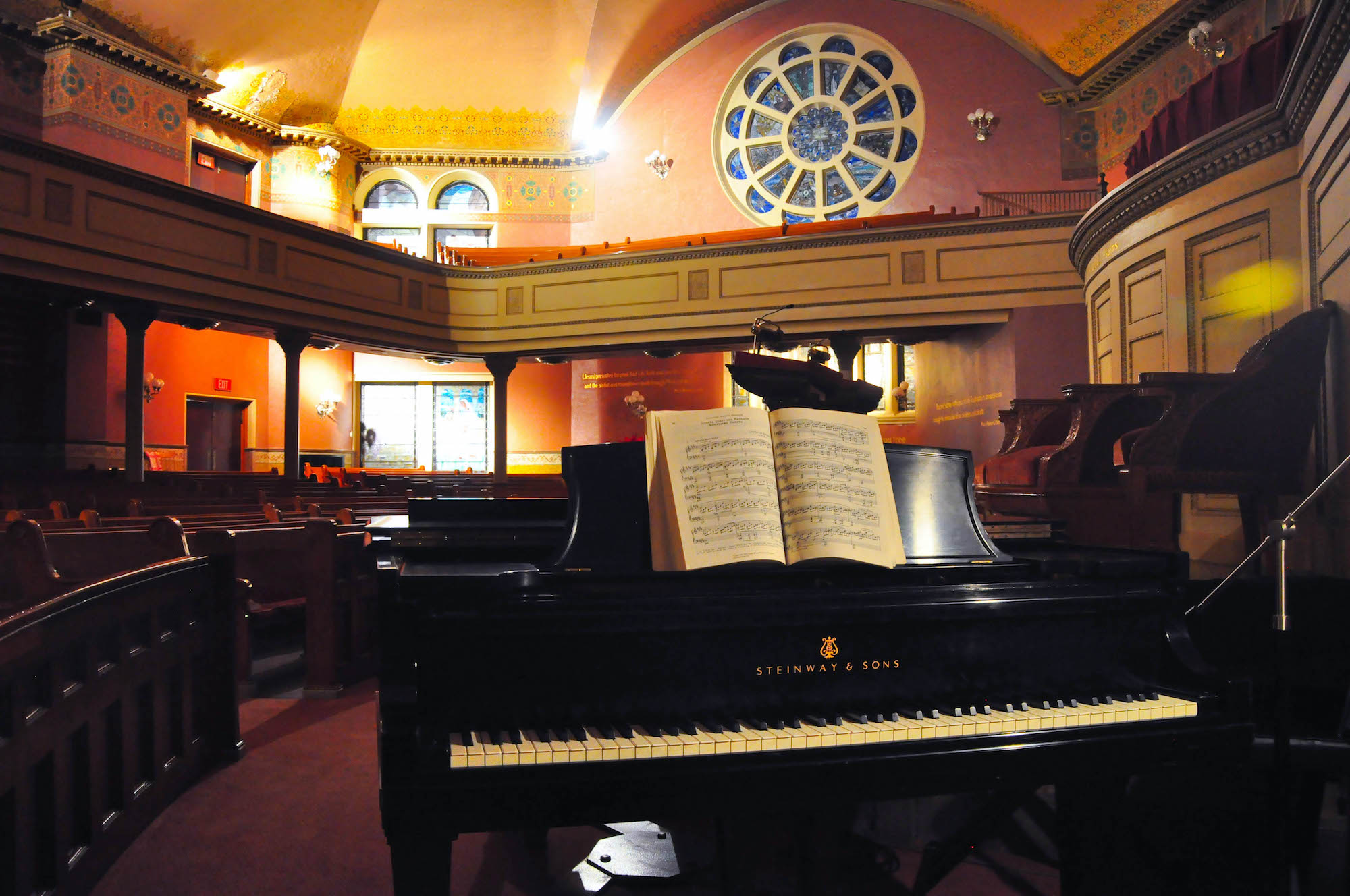Last week I was touring the East Coast with my alt-country side project The Flutterbies. One of our shows was at a church in Dover, Delaware. The chapel was beautiful—stained glass, vaulted ceilings, dark wood pews. And the acoustics in the space were amazing, the natural reverb lush and gorgeous.
Down the center aisle was a Steinway full grand piano, perfectly tuned and balanced. I sat and played an hour before our gig, digging the vibrations, resonant and lovely. During our set, I sang Leonard Cohen’s “Hallelujah” in that ambient sanctuary and I literally felt God. It was one of my most sublime artistic moments.
Since that evening, I’ve been thinking a lot about sacred spaces. Churches, temples, and shrines all seem to have the same effect on me; as soon as I step inside I feel reverent, humble, and inspired.
What is it about these places that moves me this way? What residue lingers in the air after years of prayer and devotion, hallowing a physical space, making it what Celtic Christians used to call a “thin place,” an area where the distance between the secular and sacred starts to dissolve?
What makes a place tangibly holy, and could there even be a scientific explanation for it?
Turns out, there may be.
Some quantum physicists believe we move in a field of subtle energy, much like fish swim in water. This energy sea underlies our universe; it’s so fundamental we can only perceive it indirectly. The implications are intriguing… Imagine a ship on the ocean. It leaves waves behind it as it travels. For as long as the waves churn before they melt away, the surface of the sea becomes a recording of the ship’s presence and motion. Analyzing the wave patterns, we can tell where the ship was, what direction it was moving, and possibly even how massive it is.
The energy sea in which we live is like an ocean, except unlike water, physicists theorize it’s superfluid. This means it’s a medium with no friction, so waves moving within it never melt away. The field of energy in which we live may thus be a permanent recording of universal events. The cosmos may literally have a memory.
So what does this have to do with thin places? Like any activity, religious ritual must make waves in the energy field underlying a sacred sight. Maybe years of repeated reverence cause more and more of the same kind of waves to layer and interweave into a thick tapestry of spiritually-inspired quantum energy. And maybe this energy, when repitition makes it grow sufficiently dense, becomes physically perceivable, if only subtly.
If this is true, I wonder if thin places don’t have to be only religious. What about art, dance, and recording studios? Theatre and concert stages? Some rooms just feel inspiring. That could be because we’re producing and performing alongside the energetic imprint of every artist there before us. Aided by all their muses, not just our own. And leaving our quantum footprint for whoever comes after us.
Do you have a thin place—somewhere you feel timeless, connected to powers greater than yourself?



One of my fave thin place is the Vedanta Temple in Santa Barbara. This holy space is known to me and a much beloved friend as the monkey temple. My friend and I are not above using irreverant names, words and phrases to amplify what is sacred between us.
Lots of saturated prayerful energy at the Vedanta Temple… Sometimes irreverence is the best way to be reverent. A koan.
In 2000 I met my spiritual teacher, a sufi sheikh from Senegal. For two years I practiced the 5 daily prayers of Islam. I have since been less diligent. During that time, I collected prayer rugs where I could find them, ebay mostly. The ones with significant wear at the points where the knees and head land when praying were / are very dear to me as they seem to have a ‘residual glow’ of the devoted beings that wore them threadbare with repeated prayer. I began to think about objects carrying a vibration from the people who made or used them, if this was what could be be felt by psychics. This led me to remember the Greek Orthodox monks who must remain in a prayerful state while painting Icons. Also the items made by the Baye Fall sect of Sufis in Senegal who view work as Prayer and are excused from the five prayers because of their diligent work in a prayerful state of mind. Again, in thinking of this it was a short leap to wondering if negative energy is stored in items like clothing made in sweatshops or under forced slavery where the workers are depressed and in pain. Could this be a contributing factor in the depression that seems so prevalent. Sorry to go off on a tangent Adam, this is something that has been on my mind and your writing triggered the outflow 🙂
So glad my post triggered your thinking! I’ve wondered about the energy in objects also, both positive and negative. Your comment about prayer rugs reminds me of this quote by Hujwiri:
“The Sufi is he whose thought keeps pace with his foot. He is entirely present; his soul is where his body is, and his body where his soul is, and his soul where his foot is, and his foot where his soul is.”
Adam, I just discovered your excellent blog from one of my FB “friends”. I have actually thought quite a lot myself about “thin places”–what ARE they exactly?, I have contemplated this on and off for years. The first thin place that really moved me deeply was Chartres Cathedral, which I visited in my early 20’s while hitch-hiking around France. I remember feeling “transfigured” from the moment I stepped into this deeply holy place. I even had a fantasy of getting a job as a caretaker so I could live there! Since then my life has meandered around the great temples of the world, and I understand them to be mysterious generators which seem to “align” whomever enters with the Truth. I think all of us are magnetically drawn to these places, even unconsciously.
Just to name a few beautiful thin places which I have found continuously renewing and refreshing–the inner temple of the Mahaboddhi Stupu in Bodhgaya, Swami Satchidananda’s house in Rishikesh, where he lived and taught, the entire area around Ramana Ashram in Tiruvannamalai (the cave on the mountain where Ramana lived with his mother, as well as the amazing meditation room), Angkor Wat in Cambodia, Sri Anandamayi’s samadhi site in Haridwar, Sri Ramakrishna’s ashram outside Calcutta (the small room with his bed where he carried on ecstatically with his devotees for years), Borobudur in Java,the Weeping Wall in Jerusalem, the caves of Lascaux, the Taj Mahal…….so many that I could write a book, actually! And all places where lots and lots of humans have spent time together expressing one-pointed devotion.
Buying an old and funky house got me very interested in if and how “sacred energy” can manifest out of dense and depressed energy. While researching this matter, I found that the vedic science of “vastu” has great wisdom about geomagnetic currents flow. Vast is in fact a system of architecture that was “channeled” by the ancient Rishis. These are the principles on which these ancient temples are based, and can be translated into contemporary architecture and design. From playing around with implementing these principles, I found to my amazement that it was possible for the “temple feeling” to manifest in my own environment, with no trace whatsoever of the dreary old energy. The Tibetans talk about the “dralas”, those beings who come to visit us when our spaces are clean and conscous, and we suddenly become aware of a richness, depth, beauty, and intensity we hadn’t noticed. Anyway, I am realizing that this topic you have initiated has way more tangents than I had thought. There is a lot to explore here, and I need to get out and finish fishing the algae out of my koi pond–speaking of keeping the flow of geomagnetic currents unobstructed!
But thanks so much for sharing your great writing and thinking,Adam. I have enjoyed this min-break from working in the garden today! And I enjoyed the prayer rug post as well, and loved your quote by Hujwiri. Also love both Leonard Cohen’s and K.D. Laing’s version of “Halleluia”–Thank you.
Thank you for your comment, Roberta! I’m very glad you found the blog. I must say, I’m envious of all the thin places you’ve visited. The story of your journeys would make a book I’d be very interested to read.
Thank you also for introducing me to Vastu Shastra. I’m surprised I’d never encountered it before now, and look forward to spending time online researching and learning.
Wow, Adam, I am blown away by your version of “Hallelujah”. I’ve always felt that to do justice to a song as deep and true as this one, one has to let go of all traces of “who they ever thought they were” and just let the “divine Presence” flow through. Good job in doing (or not-doing!) just that–I really love what you’ve done with this great song.
A book that I’ve lived with and shared w many friends over these past few years since about Vastu Shastra since I’ve been endeavoring to discover the best way to live “in the world”, is “The Vastu Home”, by Juliet Pegrum. The text is so clear, and makes it easy to grasp the fundamental principles–often this kind of info bores me! I first tried to absorb all of this really good information with the left brain, and quite a bit of it actually got in. But I found that in just casually spending time with the different photos of all of these really beautiful rooms in a relaxed way, I started to absorb something of what Vastu is really about in another way. In looking at these beautiful photographs and spending time with them, I discovered that I was able to “feel” how the prana flows when a space is perfectly ordered in a natural way, and suddenly I began to “see” how I needed to move things around in my own house to allow this “flow” to flow. Anyway, this is of course one of those “endless journeys”, as one continues to discover greater levels of subtlety and deeper expression the more one stays with this way of viewing reality. One of my Teachers spoke about human evolution as “awakening to greater and greater degrees of integration and refinement”. I am certainly finding this true in my own life, and think I’ll probably enjoy “tweaking” my own house/temple to allow greater fullness and energy flow and openness until I croak!
Thank you for your compliments, Roberta. I’m so glad you enjoyed my rendering of “Hallelujah.”
I’ll check out THE VASTU HOME. Though lately, I’m doing less studying of others’ wisdom and more gut-level experiencing of my own. If a space feels right, it’s right.
I love your teacher’s quote about “…greater degrees of integration and refinement.” My lifelong goal.